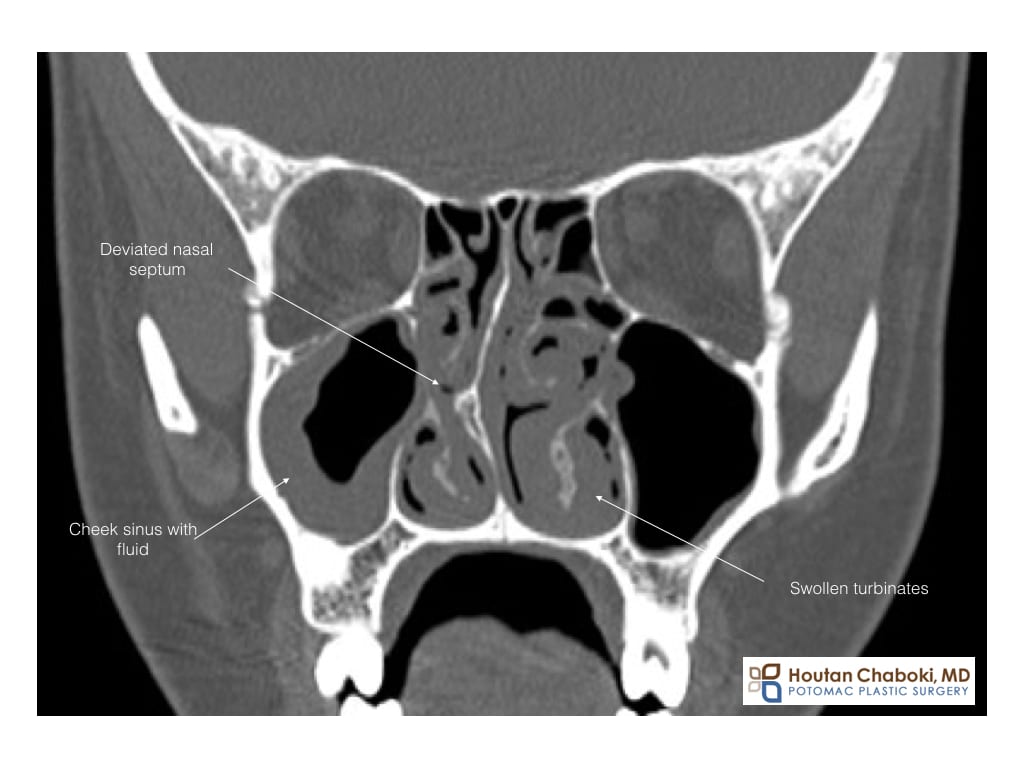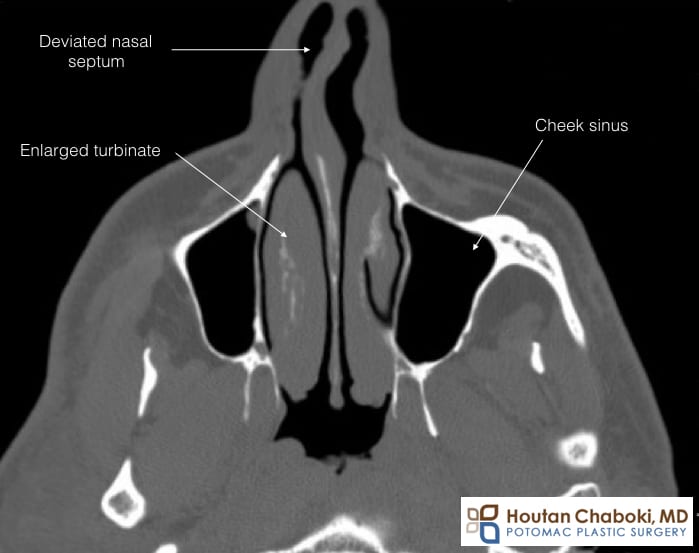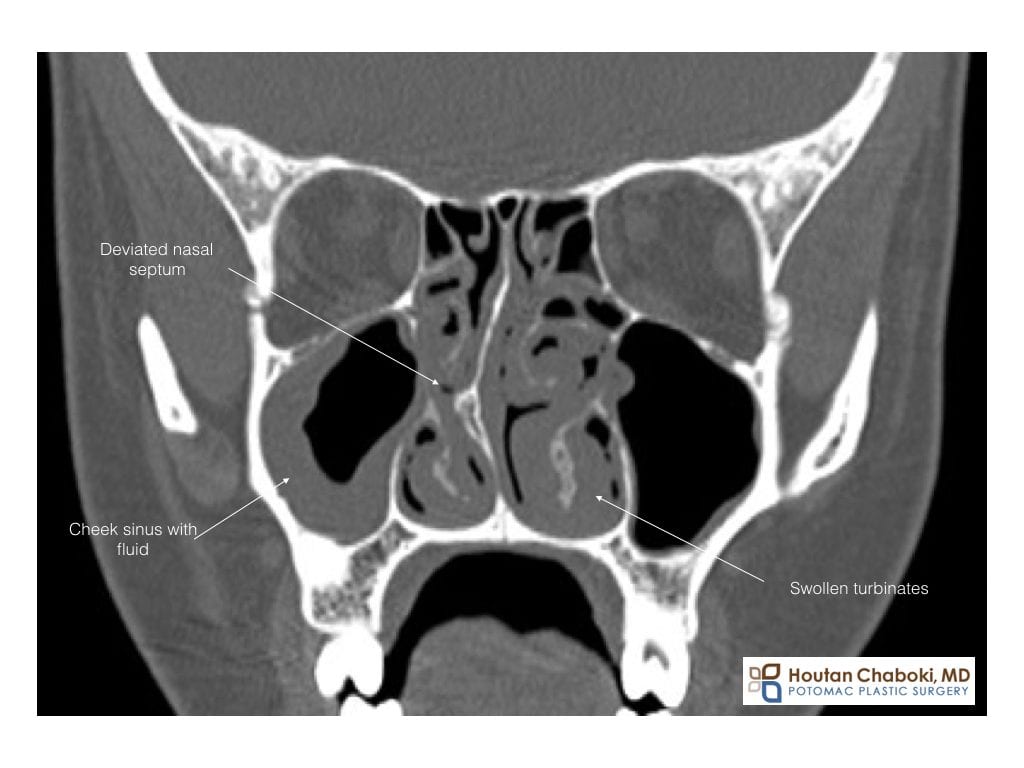
CT scan of nose and sinus showing deviated septum, enlarged turbinates, and sinus swelling. Rhinoplasty surgeons may review a CT scan prior to cosmetic surgery.
Washington DC rhinoplasty patients choose plastic surgery on their nose for a variety of reasons. Many patients want rhinoplasty to reduce the bump and size of their nose. Some want to narrow or lift the nasal tip. Some want to improve nasal symmetry, either from genetics or prior injury. Most patients, however, want to improve their nasal breathing and appearance of the nose at the same time.
Nasal congestion has many contributing factors for each patient. There isn’t one factor that is universal for all patients. Swelling, generally speaking, is a very common factor for many patients. The nose can swell for a variety of reasons, such as allergies, diet, hormones, infection, surgery, and gravity. The part of the nose that tends to swell the most is the nasal turbinate, specifically the inferior turbinate.
What are the nasal turbinates?
The nasal turbinates are a normal part of the nose and sinus structures. Patients have three turbinates inside each nasal cavity: an inferior, middle, and superior. The turbinates consist of bone in the center, a highly vascular and spongy tissue in the middle, and a mucous membrane outer lining. The turbinates warm, humidify, and clean the air we breathe. These structures also play a role in sensation of smell.
Turbinates vary in size, with the inferior turbinate being the largest. Being the largest, the inferior turbinate contributes the most to nasal, sinus, and allergy symptoms. The inferior turbinate can change size dramatically. Normally throughout the day, the turbinates will swell and shrink. Turbinates can swell from factors such as temperature, gravity, infection, allergies, hormones, emotions, and dust.
Large or hypertrophied turbinates commonly contribute to nasal symptoms. In some, the turbinate will remain enlarged and obstruct the nasal airway, resulting in a congested feeling. When the cause of the problem is treated, such as allergy or infection, the turbinate will shrink back to its normal size. Sometimes the inferior turbinate will remain swollen even if the underlying problem is corrected. Common symptoms from large turbinates include nasal congestion, nasal obstruction, difficulty breathing through the nose, and snoring. The symptoms may be worse on one side or alternate sides. Symptoms may appear during the day or may appear primarily at night. In some patients, the sinus drainage may be inhibited, resulting in post-nasal drip or repeated sinus infections.

CT scan of nose and sinus showing deviated septum and enlarged turbinates. Rhinoplasty surgeons may review a CT scan prior to cosmetic surgery.
How are the turbinates reduced?
Turbinate surgery reduces the size of enlarged inferior turbinates in most cases. Turbinate reduction or turbinoplasty are other terms for surgery on the nasal turbinates. Turbinate reduction can be performed in isolation, but is usually combined with septoplasty, sinus surgery, or rhinoplasty. The nasal turbinate can be reduced in several ways via mechanical and/or energy methods:
- Reducing or shrinking the inside portion, leaving the outer mucosa lining intact
- Directly cutting or removing a portion of bone, spongy tissue, and/or mucosa
- Pushing the turbinate outward or to the side (ex. out-fracture)
- Combination of the above
Surgery on the turbinates is done with specialized equipment, headlights, and endoscopic cameras. Turbinate reduction alone can be performed in the office via local anesthesia in appropriate patients. Turbinate reduction when combined with septoplasty and rhinoplasty is more likely to be performed via IV sedation or general anesthesia. All methods of turbinate surgery can be performed entirely through the nostrils without external incisions (i.e. closed approach to rhinoplasty).
Occasionally, the turbinate tissue will re-grow or re-swell despite turbinate surgery, and the procedure may need to be repeated.
What is recovery like after turbinate reduction or turbinoplasty?
Recovery after turbinate reduction alone is relatively quick. A short period of increased congestion and mucous may occur from surgical swelling before symptoms improve. Mild discomfort may be present for a couple of hours or days. Patients may return to work and school after turbinate reduction. Exercise is not allowed usually for a couple of weeks. No cast is required after turbinate reduction, unless combined with rhinoplasty.
Is turbinate reduction normally performed with rhinoplasty?
Turbinate reduction or turbinoplasty is often performed with rhinoplasty. First, many patients who have rhinoplasty also have a deviated septum, large turbinates, and chronic nasal congestion. For these patients, rhinoplasty may be combined with turbinate reduction, septoplasty (surgery on a deviated septum), and possibly nasal valve or sinus surgery. In addition, rhinoplasty to reduce the size of the nose is normally combined with septoplasty and turbinate reduction to increase the size of the internal nasal passages to maintain or improve nasal breathing. Turbinate reduction doesn’t add much to the recovery of rhinoplasty and should be discussed with your rhinoplasty surgeon.
Have more questions? Schedule a consultation to learn more. Also, if you haven’t already, review our nasal surgery FAQ too for related information. Dr. Chaboki performs office procedures to improve nasal obstruction via awake, local anesthesia.


Leave a Reply